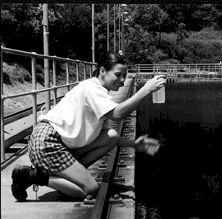Chemist - Peta Thiel |
Back to Careers in Science |
|
My pet fish and I have a lot in common with the rest of the Australian population - we all need safe, clean water. In Australia in the 1990s, most people have access to plentiful supplies of safe, clean drinking water. But that wasn't the case earlier this century and it still isn't the case in some other countries, where using dirty water for washing and cooking can spread serious diseases such as cholera and typhoid. In Australia, our water is usually treated to make sure it is potable (safe to drink). Keeping our water safe starts with ensuring the catchment areas around dams are clean. Then it's my turn. My job with the Landers Shute Water Treatment Plant is to analyse the water for its pH (level of acidity), various chemicals such as heavy metals and toxic organic compounds, and harmful bacteria or other micro-organisms. I am also helping to test a new filter for removing manganese from the waste water that comes from the water treatment plant that produces our shire's drinking water. If manganese is present in high concentrations, it can stain laundry and porcelain, cause taste and odour problems, or build up inside pipelines. The filter uses greensand, which is purple-black rather than green, and is made from a type of volcanic sand processed to absorb iron and manganese. If our filter can successfully remove the manganese, we will be able to put the waste water back into the treatment plant and use it to produce more clean drinking water. Similar filters are used around the world to remove iron and manganese from water, but our filter is capable of removing a much wider range of manganese concentrations.
|
 |
|
This work is reproduced from the Women in Science Enquiry Network "Science Futures" was produced by Wisenet with the aid of a grant from the Department of Industry, Science and Tourism Science and Technology Awareness Program. |